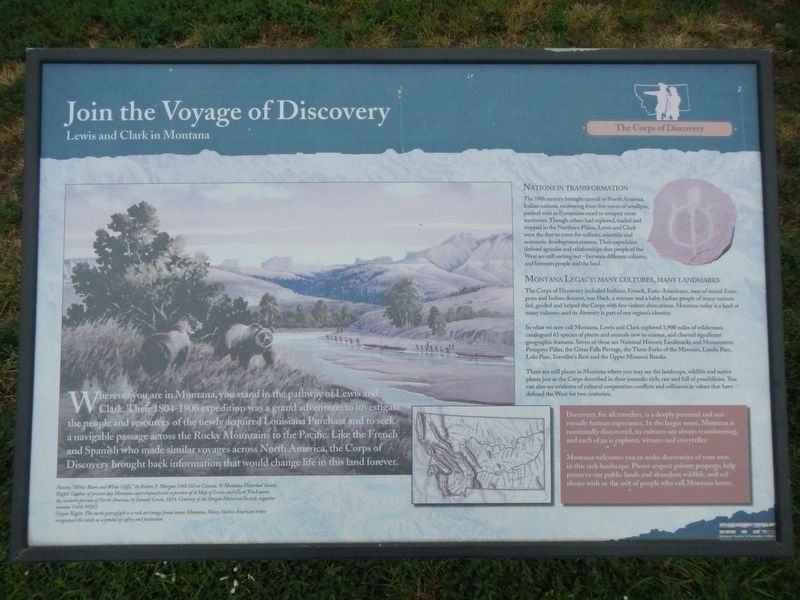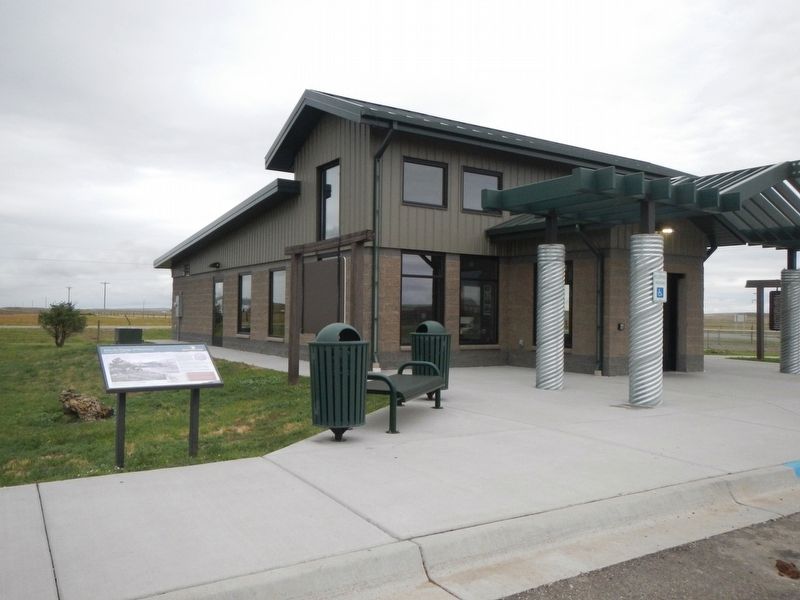Near Brockway in McCone County, Montana — The American West (Mountains)
Join the Voyage of Discovery

Photographed By Barry Swackhamer, August 17, 2019
1. Join the Voyage of Discovery Marker
Captions: (bottom left) Above: "White Bear and White Cliffs," by Robert F. Morgan 1988 Oil on Canvas © Montana Historical Society. Right: Outline of present day Montana superimposed over a portion of A Map of Lewis and Clark Track across the western portion of North America by Samuel Lewis. 1814. Courtesy of the Oregon Historical Society negative no. OrHi 99293. Upper Right: The turtle petroglyph is a rock art image found across Montana. Many Native American tribes recognize the turtle as a symbol of safety and protection.
Nations in Transformation
The 19th century brought tumult to North America. Indian nations, recovering from five waves of smallpox, pushed west as Europeans raced to conquer more territories. Though others had explored, traded and trapped in the Northern Plains, Lewis and Clark were the first to come for military, scientific and economic development reasons. Their expedition defined agendas and relationships that people of the West are still sorting out - between different cultures, and between people and the land.
Montana Legacy: Many Cultures, Many Landmarks
The Corps of Discovery included Indians, French, Euro-Americans, men of mixed European and Indian decent, one black, a woman and a baby. Indian people of many nations fed, guided and helped the Corps with few violent altercations. Montana today is a land of many cultures, and its diversity is part of our region's identity.
In what we now call Montana, Lewis and Clark explored 1,900 miles of wilderness, catalogued 63 species of plants and animals new to science, and charted significant geographic features. Seven of these are National Historic Landmarks and Monuments: Pompeys Pillar, the Great Falls Portage, the Three Forks of the Missouri, Lemhi Pass, Lolo Pass, Traveller's Rest, and the Upper Missouri Breaks.
There are still places in Montana where you may see landscape, wildlife and native plants just as the Corps described in their journals: rich, raw and full of possibilities. You can also see evidence of cultural cooperation, conflicts and collisions in values that have defined the West for two centuries.
(sidebar)
Discovery, for all travelers, is a deeply personal and universally human experience. In the larger sense, Montana is continually discovered, its cultures are always transforming, and each of us is explorer, witness and storyteller.
Montana welcomes you to make discoveries of your own in this rich landscape. Please respect private property, help preserve our public lands and abundant wildlife and celebrate with us the mix of people who call Montana home.
Erected by Montana Department of Transportation.
Topics and series. This historical marker is listed in this topic list: Exploration. In addition, it is included in the Lewis & Clark Expedition series list.
Location. 47° 19.504′ N, 106° 10.283′ W. Marker is near Brockway, Montana, in McCone County. Marker can be reached from the intersection of State Highway 200 at milepost 248 and South Flowing Wells Road, on the left when traveling west. Touch for map. Marker is in this post office area: Brockway MT 59214, United States of America. Touch for directions.
Other nearby markers. At least 2 other markers are within walking distance of this marker. Fort Peck Dam and Lake (here, next to this marker); Dinosaurs (within shouting distance of this marker).
More about this marker. This marker is at the Flowing Wells Rest Area. This marker is also found at several other Lewis and Clark sites.
Credits. This page was last revised on December 6, 2019. It was originally submitted on December 6, 2019, by Barry Swackhamer of Brentwood, California. This page has been viewed 167 times since then and 12 times this year. Photos: 1, 2. submitted on December 6, 2019, by Barry Swackhamer of Brentwood, California.
